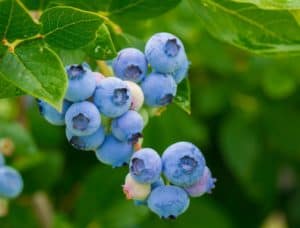 Multiple modes of action coupled with zero pre-harvest interval offer big benefits to growers.
Multiple modes of action coupled with zero pre-harvest interval offer big benefits to growers.
While many pests feed on just fruit, or just foliage, blueberry gall midge uses a two-pronged attack. The larvae feed on flower buds early in the season, moving on in later generations to the vegetative buds. Without proper management, the yield is significantly reduced – sometimes by as much as 80% – and the plants are weakened.
Blueberry gall midge is a particular challenge for growers because of its lifecycle and where it feeds. Once inside the flower or leaf buds, the larvae are difficult to reach with spray applications. Monitoring the emergence of the adult midges from the soil in the spring and applying insecticides during the small window before they lay eggs on the buds is the key to control.
Target the Timing
The tiny adult midges are about the size of a fruit fly and are difficult to see. One way to detect them is with a bucket emergence trap, which is made by cutting the bottom out of a five-gallon bucket and covering the opening with a sticky, transparent sheet. Place the other end firmly into the soil near a blueberry bush. As the midges emerge from the soil, they get trapped on the sticky sheet. Another method is to place a 1’ x 1’ sticky panel on a stake at about half the height of the blueberry bush with the sticky side facing the bush. Both types of traps should be monitored weekly.
Once the midges are seen, it’s time to act, because they only live for a few days. But during that time, females lay eggs in the flower or leaf buds as soon as they start to swell and open. The larvae feed within the buds, destroying them. Flower buds dry up and shrivel and vegetative buds become distorted and shoot tips turn black within just a few weeks of infestation. The larvae eventually drop to the ground to pupate and create the next generation.
Why Botanical Oils?
A number of conventional chemistries will kill the adult midges. Ecotrol Plus, a botanical oil made by KeyPlex, kills the adults, eggs, and nymphs on contact. It also offers advantages conventional sprays don’t, such as repellency and disruption of oviposition (egg-laying).
Gerald O’Connor, CEO of KeyPlex, recommends at least two or three sprays and possibly more during the season.
“Apply Ecotrol Plus at budding and again three weeks after to catch any you missed,” O’Connor says. “And because gall midges can have multiple generations – up to five or six in the southeastern U.S. – it’s important to keep monitoring and applying throughout the season. For the adults, we recommend a rate of three quarts per acre, or tank-mixing Ecotrol with another adulticide such as Admire or Movento.
O’Connor says tank-mixing Ecotrol Plus with other insecticides helps those products work better.
Spraying the borders of the field with Ecotrol Plus is an excellent way to use its repellency to keep midges from traveling from one field to another. The repellant qualities also disturb any surviving adults and disrupts oviposition. Since the adults only live a few days, this can make a big difference.
Ability to Spray Late in Season
The active ingredients in Ecotrol Plus are rosemary oil, geraniol and peppermint oil, which are GRAS (Generally Recognized As Safe) by the Food and Drug Administration (FDA). This means there is no worker re-entry interval, no pre-harvest interval and no maximum residue levels to worry about. Blueberries can be sprayed with Ecotrol Plus right up to and including the day of harvest.
O’Connor says that’s a key benefit when it comes to another pest of blueberries – spotted wing drosophila (SWD), which causes damage to the ripe fruit.
“The ability to use botanical oils to prevent SWD damage just before harvest is a major advantage not offered by other classes of pesticides,” O’Connor says. “It gives growers a tool to use to protect their crop right up until the end. In addition, botanical oils have multiple modes of action (MOA) and are an excellent rotation partner with other pesticides. Because of these multiple MOA’s, it is nearly impossible for insects to develop resistance to botanical oils.”
